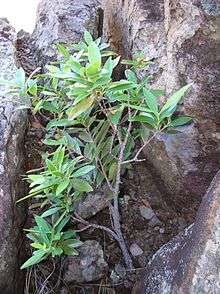Wikstroemia oahuensis
| ʻĀkia; Oʻahu False Ohelo | |
|---|---|
 | |
| Scientific classification | |
| Kingdom: | Plantae |
| (unranked): | Angiosperms |
| (unranked): | Eudicots |
| (unranked): | Rosids |
| Order: | Malvales |
| Family: | Thymelaeaceae |
| Genus: | Wikstroemia |
| Species: | W. oahuensis |
| Binomial name | |
| Wikstromeia oahuensis | |
ʻĀkia or Oʻahu false ohelo (Wikstroemia oahuensis) is a species of flowering shrub in the mezereon family, Thymelaeaceae, that is endemic to Hawaiʻi.[1]
Description
In the wild, ʻākia can grow to 5 feet (1.5 m) tall, but in cultivation it usually reaches 3 feet (0.91 m) with a diameter of 10 feet (3.0 m). The young branches are gray, yellow, or reddish brown. The leaves grow with two leaves opposite each other on the branch, overlapping, and are dark green or grayish on the upper surface and lighter green underneath. They are oval to round and usually under 1 inch (2.5 cm) long. This species is highly variable, with the leaves ranging from large and long to small and round. The stems do not snap but peel when bent. It flowers irregularly throughout the year, but produces fewer flowers when the plant has mature fruit. The tubular yellow to yellow-green flowers may be perfect (bisexual) or unisexual (either male or female), and less than 0.5 inches (1.3 cm) long.[2] The dwarf bog form from Kauaʻi is sometimes recognized as a separate species, W. palustris.
Distribution
There are 12 Wikstroemia species endemic to the Hawaiian Islands. Wikstroemia oahuensis is a relatively common plant in a wide variety of habitats on the islands of Kauaʻi, Oʻahu, Molokaʻi, Lānaʻi, and Maui. It inhabits ridges and rocky areas, hala (Pandanus tectorius) forest, mesic forest, wet forest, and bogs at elevations of 100–1,400 metres (330–4,590 ft).[3]
Uses
Toxicity
Native Hawaiians used this species to stupefy fish.[1] A poison made from ʻākia in combination with other plants was used to execute criminals.[3]
Medicinal
Hawaiian medicinal uses are as a laxative and for treatment of asthma. Possible anti-tumor activity.[2]
Other
ʻĀkia is used in Hawaiʻi as landscape specimen. Seeds and flowers are used to make beautiful lei.[2]
References
| Wikimedia Commons has media related to Wikstroemia oahuensis. |
- 1 2 Little Jr., Elbert L.; Roger G. Skolmen (1989). "ʻAkia" (PDF). United States Forest Service.
- 1 2 3 "Wikstroemia oahuensis". Meet the Plants. National Tropical Botanical Garden. Retrieved 2009-02-28.
- 1 2 "ʻakia, kauhi, ʻakia manolo". Hawaiian Ethnobotany Online Database. Bernice P. Bishop Museum.